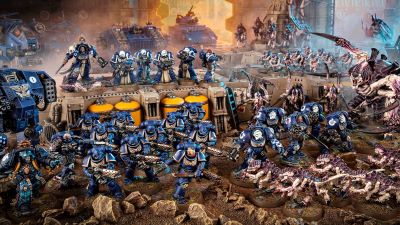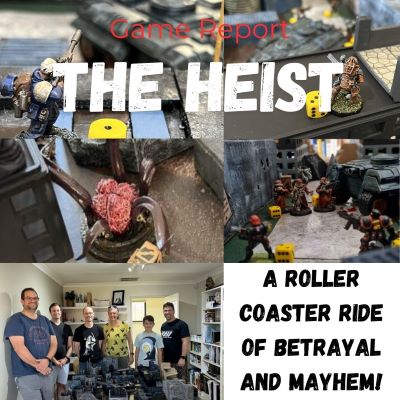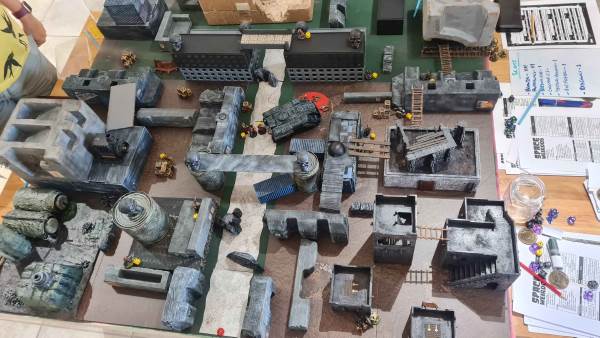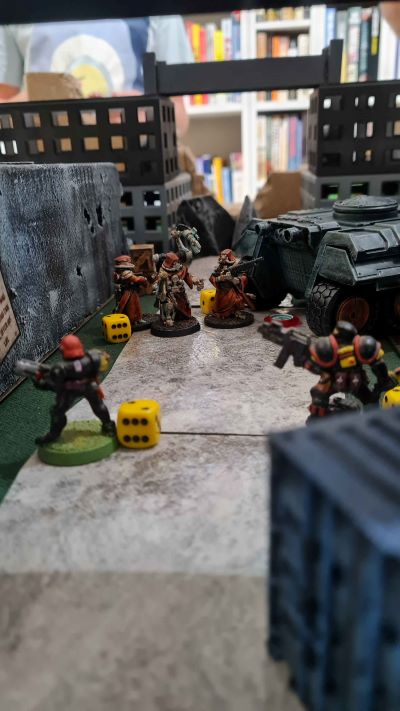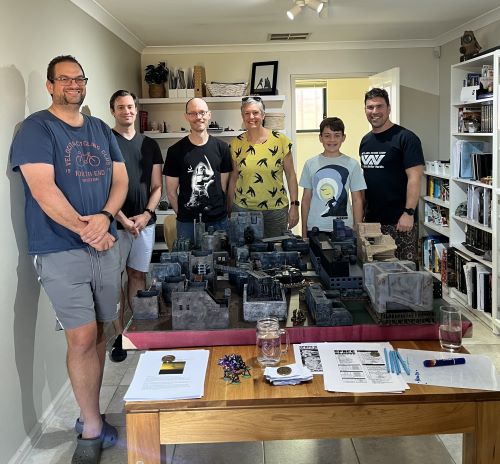One of things I love about Dungeons and Dragons campaigns is the worldbuilding. Particularly when the world advances and changes through the player actions and creativity. My long standing Salkire campaign evolved from a ruined city to a huge world with kingdoms, factions and villains vying for attention. All formed through gameplay and collaboration between my players and me, as DM. Over the last couple of years I have rediscovered sci fi wargaming with a particular focus on Warhammer 40K lore. I discovered the incredible Corvus Cluster, a long running blog tying together a groups games into one long running and immersive campaign. Ultimately, not too dissimilar to a long term D&D campaign really. Using this as inspiration I wanted to do similar worldbuilding for my own 40K inspired games. Mordax Prime is the result.
What is Mordax Prime
Mordax Prime a sector of space in the Warhammer 40K universe that I have developed as a narrative backdrop for my 40K inspired games. While I have retrofitted some of my previous games into this Sector, future games will be informed by and change the setting. My hope is that the setting begins to take a life of it’s own. Dictated by the outcomes of games and player actions. As mentioned previously this is narrative focused, providing colour and setting to our games. Players will know that game outcomes will have impact and I hope that this will add flavour not present in a normal game.

The Mordax Sector begins the campaign under Imperial control. Of course, this is likely to change as the narrative progresses.
Current Worlds
These were easy to develop using AI prompts as well as additions from my own imagination. I knew that I needed Luthca IV and a jungle death world, based on previous skirmish games I’d run. Other than that I was open to other 40K tropes like the forge and hive worlds. The last addition was the navy watch station. As I’d had pirate captain Mad Claw make an appearance in a game I want to explore this narrative a bit more. An Imperial naval port is exactly the location needed to help it play out in an exciting way.
So far, Mordax Prime comprises the following worlds. Of course new worlds and clusters may appear over time as the narrative dictates. As you can see from the descriptions below there is plenty of scope for conflict already.
Helios Magna (Hive World and Sector capital)
Description: A sprawling, industrial hive world teeming with millions of souls and the Administratum center for the system. Its vast manufactorums supply weapons and armor for the Imperial Guard. The towering spires of the hive cities are hotspots for intrigue and rebellion, making it a critical point of interest for both Imperial and Chaos forces.
Strategic Importance: Helios Magna’s output is vital for sustaining Imperial war efforts. Control of this planet secures supply lines and access to vast manpower resources.
Challenges: Frequent underhive uprisings and the ever-present threat of Genestealer Cult infiltration.
Verdantia Prime (Death World)
Description: A lush, verdant world filled with dangerous flora and fauna. The thick jungles are a perfect hiding place for renegades and xenos. It’s rumored to be home to ancient artifacts of great power.
Strategic Importance: Control of Verdantia Prime offers access to rare resources and strategic defensive positions. It’s also a key site for potential xeno-archaeological discoveries. Thought to house a top secret Dark Angels training facility.
Challenges: Navigating treacherous terrain and dealing with constant ambushes from Tyranid bioforms or feral Chaos cultists.
Aetherion V (Forge World)
Description: A heavily fortified forge world, Aetherion V is known for its production of advanced weaponry and vehicles. It is a linchpin in the sector’s defenses, equipped with formidable orbital platforms and ground-based macro-cannons.
Strategic Importance: Control of Aetherion V ensures a steady flow of high-quality wargear and defensive capabilities. It’s also a prime target for sabotage by the Chaos Space Marines.
Challenges: Infiltration by Chaos cults and the risk of large-scale conflicts breaking out in its production facilities.
Luthca IV (Industrial World)
Description: Highly productive factorium world built over ancient ruins. Supplies nearby sectors with manufacturing and agricultural machinery. Caches of archaeotech are thought to lie hidden deep within the Cinder Desert and in the roots of the hive cities.
Strategic Importance: While of lower manufacturing importance than Luminara Secundus, Luthca IV is the focus of many expeditions looking for ancient artefacts thought to provide great power..
Challenges: Both Chaos cults and Xenos vie with Imperial and Mechanicus agents in the search for forbidden tech. It is also rumoured that a Chaos gate lies buried deep beneath Hive Secundo.
Watchpoint Epsilon (Imperial Port)
Description: Key naval station providing patrols of nearby warp lanes.
Strategic Importance: Home of Watchfleet Epsilon, key in the defense of the Sector and nearby warp lanes.
Challenges: Seen as a backwater posting has led to dissatisfaction and potential heresy amongst some of the officer cadre.
Luminara Secundus (Pleasure World/Trade Hub)
Description: Known for its beautiful landscapes and luxury, Luminara Secundus serves as a retreat for the sector’s elite and a bustling trade hub. Its relative tranquility makes it an ideal location for diplomacy or covert operations.
Strategic Importance: Though less militarized, control of Luminara Secundus provides economic leverage and a base for Rogue Traders. It also serves as a critical node for intelligence gathering.
Challenges: The planet’s affluence attracts both political machinations from Imperial Nobles and covert infiltration by Chaos agents.
Active Factions
A number of factions are thought to be active within Mordax Prime. These are listed below with significant personalities coming from previous games and player invention.
- Inquisition: Rooting out heresy and maintaining order.
- Inquisitor Jaegermann: Ordo Hereticus seeking out daemonic influences with the Imperial hierarchy.
- Rogue Traders: Seeking profit and ancient relics.
- Benedictus Sixtus: notorious Rogue Trader known to play all sides. Fond of tall tales.
- Imperial Nobles: Defending their estates and political power.
- The Duchess: Leader of the most powerful family on Helios Magna.
- Sisters of Battle: Purging heretics and xenos.
- Enclave of the Veiled Light: Located on Helios Magna.
- Space Marines: Responding to major threats with precision strikes.
- Dark Angels: Secret training base in the jungles of Verdantia Prime.
- Lancet Hereticus: Elements of this Inquisition controlled chapter thought to be active in this sector.
- Imperial Guard: Garrisoning key locations and mounting large-scale defenses.
- Tyranids: Emerging from hidden bio-ships, consuming everything in their path.
- Possibly identified on Verdantia Prime. Thought to be connected to the researches of the late radical Inquisitor Tiberious Glaze.
- Genestealer Cult: Sowing rebellion from within.
- Heralds of the Star Children: active on Luthca IV, threat level high. Currently being investigated by Dark Angels and agents of the Inquisition.
- Forces of Chaos: Undermining Imperial control and seeking to bring the sector into the warp.
- Acolytes of the Red Mist: active on Luthca IV threat level unknown.
- Mad Claw Crew: notorious pirate currently working from a secret location in the Starfire Shallows.
Plenty of scope for interesting battles, with room enough for additional factions as play progresses.
Current Campaign Log
This was a really fun part of the worldbuilding for me. Placing past games into the sector started uncovering links between factions and planets. Consequently, Mordax Prime is beginning to feel more than a map with some planet names. Life has been breathed into it.
356.658.M41 Unrest on Luthca IV
During a period of unrest on Luthca IV an Inquisitor, Enforcers, Planetary Guard, Acolytes of the Red Mist, Mining Guild and Infractionist gangs fought a vicious skirmish. Each group was making the most of the unrest to pursue their own agendas. Ultimately, Inquisitor Jaegermans retinue won the firefight retrieving the infamous Chaos artefact “Belial Goblet”.

357.020.M41 Echoes of Xenos
Located in the nearby Lupin Sector, Rogue Trader Benedictus Sixtus competed with various Inquisitors and Adeptus Mechanicus to retrieve heretical research of the late Ordo Xenos Inquisitor Tiberious Glaze. The battle raged over a number of sectors and moons as the warbands pursued the trail of clues. Despite battling an emergent Xenos threat Sixtus escaped with the research and fled to the Mordax Sector intent on finding a buyer.

357.125.M41 Jungle Hunt
Imperial troopers of the navy and guard pursued the downed vessel of the notorious pirate captain Mad Claw into the jungles of the death world Verdantia Prime. A vicious firefight broke out between the renegades and the brave Imperial patrol. The noise of the firefight awoke some xenos terrors of the jungle, who grabbed combatants from both sides from the leafy darkness. Those lost were never seen again. Unfortunately, Mad Claw and his allies applied superior tactics and fought their way to freedom. The Captain and his crew are thought to be hiding in the Starfire Shallows nursing their hunger for revenge.
It is rumoured that some of the research uncovered by Benedictus Sixtus has made its way to the planet surface. But how or why is unknown.

357.450.M41 Potential Heresy on Helios Magna
A small but lethal force of suspected Dark Angel space marines assaulted an Ecclesiarchy compound on Helios Magna. The garrison of Adepta Sororitas (Order of the Veiled Light) scrambled quickly to defend. However, could not match the firepower of the marines and their formidable dreadnought. By the time reinforcements arrived the Dark Angels had disappeared as mysteriously as they had appeared, their objective unknown.

357.556.M41 The Heist: Luthca IV
On the edge of Hive Secundo a multitude of gangs competed to retrieve a dangerous xenos artefact from the convoy of a Mechanicus expedition. What started as a tense standoff erupted into extreme violence as the hivers made and broke alliances while mercilessly blasting one another. Before order could be restored the artefact was opened releasing a powerful daemonic entity onto the planet. Few survivors lived to tell the tale. Yet, the Planetary Governor has requested aid to eliminate the creature.


357.790.M41 Verdantia Prime Ambush
A Dark Angels patrol was ambushed by an unidentified xenos threat whilst on a training exercise in an abandoned outpost on Verdantia Prime. The space marines fought with characteristic courage obliterating the opposing force. Needless to say, agents of the Inquisition are currently investigating the source of this surprising incursion. It is rumoured amongst those who know that the xenos threat is connected to the research purloined by Benedictus Sixtus and his crew. This incident has been linked to the Xenos discovered during the pursuit of Mad Claw and his gang.

357.800.M41 Heralds of the Star Children Bomb threat
Local enforcers on Luthca IV uncovered a plot to destroy the primary administratum building on Hive Primus. Members of the Heralds of the Star Children placed a large explosive device with the vicinity. Fortunately, it wasn’t set properly giving a small Dark Angels detachment the chance to intercept.
A vicious firefight erupted within the shadowed streets below the administratum. The Heralds employed a psyker of note giving the space marines a difficult time of things. Fortunately, the heroes of the Imperium killed wiped out the xenos heretics and diffused the bomb, saving the Hive from a terrible fate. Inquisitor Mattias Criese has been assigned the investigation of the rogue psyker and this cult, which are both now more than just minor annoyances.

357.850.M41 Xenos Hunt
Following the recent thwarted bomb threat on Luthca IV by Dark Angels Forces, Inquisitor Criese has been actively investigating the Heralds of the Star Children. In an effort to prevent any further insurrection the Inquisitor has dispatched a crack team of agents to take out Magos Drevender the revered leader of the cult.
The kill team tracked him down into the depths of Hive Primus. But before they could raid the xenos cult an unseen sentry alerted the Magos. Cult members frenziedly assaulted the agents trying to buy time for their illustrious leader to escape. However, Drevender couldn’t quite get there. Instead, he was gunned down by two agents in a hail of bolter shells.
So ended the uprising of the Star Children. The next battle will explore a different narrative from Mordax Prime.

Final thoughts on Worldbuilding
This exercise in worldbuilding has been a lot of fun. Tying together the battles into a narrative was much easier than expected and the sector began to take on a life of its own. Are the remnants of the Star Children thirsting for revenge? Will teh Sisters of Battle start investigating the Dark Angels? Where will Mad Claw and his pirates raid next? Is the chaos gate open and what came through? Will the Tyranid presence on Verdantia Prime summon a larger invasion fleet? So many options for exciting games ahead.
Spending a bit of time developing a campaign world for your games is a fun exercise and adds a fantastic narrative aspect to your games. I highly recommend.
How have you had success developing campaign backgrounds?
A big shoutout to Corvus Cluster as an amazing source of inspiration!

